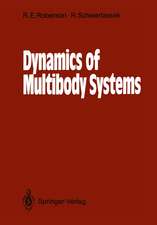Computational Mechanics of the Classical Guitar
Autor Rolf Baderen Limba Engleză Paperback – 14 oct 2010
| Toate formatele și edițiile | Preț | Express |
|---|---|---|
| Paperback (1) | 635.65 lei 43-57 zile | |
| Springer Berlin, Heidelberg – 14 oct 2010 | 635.65 lei 43-57 zile | |
| Hardback (1) | 641.85 lei 43-57 zile | |
| Springer Berlin, Heidelberg – 8 dec 2005 | 641.85 lei 43-57 zile |
Preț: 635.65 lei
Preț vechi: 747.82 lei
-15% Nou
Puncte Express: 953
Preț estimativ în valută:
121.67€ • 132.21$ • 102.27£
121.67€ • 132.21$ • 102.27£
Carte tipărită la comandă
Livrare economică 21 aprilie-05 mai
Preluare comenzi: 021 569.72.76
Specificații
ISBN-13: 9783642064258
ISBN-10: 3642064256
Pagini: 200
Ilustrații: XVI, 182 p.
Dimensiuni: 155 x 235 x 11 mm
Greutate: 0.29 kg
Ediția:Softcover reprint of hardcover 1st ed. 2005
Editura: Springer Berlin, Heidelberg
Colecția Springer
Locul publicării:Berlin, Heidelberg, Germany
ISBN-10: 3642064256
Pagini: 200
Ilustrații: XVI, 182 p.
Dimensiuni: 155 x 235 x 11 mm
Greutate: 0.29 kg
Ediția:Softcover reprint of hardcover 1st ed. 2005
Editura: Springer Berlin, Heidelberg
Colecția Springer
Locul publicării:Berlin, Heidelberg, Germany
Public țintă
ResearchCuprins
The Musical Transient-Modeling Software MTMS Developed for this Study.- Continuous and Discrete Mechanics.- Studies of the Guitar To Date.- The Discrete Guitar Model.- Bending, Damping and Coupling.- Results.- Summary and Outlook.
Recenzii
From the reviews:
"Dr. Bader’s book would be of keen interest to … those who are interested in complex boundary element methods in acoustics and computational modelling. It may also be ideal for acousticians involved in uncovering the secrets of the mystical geometries of the classical guitar … . The book includes 65 figures and illustrations and addresses many areas of practical interest related to the guitar … . my impression is that the book is a broad and accessible text on the dynamics of the guitar." (Salem Hertil, International Journal of Acoustics and Vibration, Vol. 11 (3), 2006)
“The book in question is part of this type of research work and gives an accurate, detailed analysis of the structural components of a classical guitar, proposing mathematical models featuring various levels of complexity. … even luthiers, with the aid of skilled input, might find this book interesting with a view to obtaining useful suggestions that could help them improve prototype development.” (Bruno Pizzigoni, Meccanica, Vol. 45, August, 2010)
"Dr. Bader’s book would be of keen interest to … those who are interested in complex boundary element methods in acoustics and computational modelling. It may also be ideal for acousticians involved in uncovering the secrets of the mystical geometries of the classical guitar … . The book includes 65 figures and illustrations and addresses many areas of practical interest related to the guitar … . my impression is that the book is a broad and accessible text on the dynamics of the guitar." (Salem Hertil, International Journal of Acoustics and Vibration, Vol. 11 (3), 2006)
“The book in question is part of this type of research work and gives an accurate, detailed analysis of the structural components of a classical guitar, proposing mathematical models featuring various levels of complexity. … even luthiers, with the aid of skilled input, might find this book interesting with a view to obtaining useful suggestions that could help them improve prototype development.” (Bruno Pizzigoni, Meccanica, Vol. 45, August, 2010)
Textul de pe ultima copertă
This book performs a state-of-the-art finite-difference calculation of the complete geometry of the classical guitar as a time-stepping application. It provides insight into the overall behaviour as well as the finite structure mechanisms of this musical instrument. Fundamental problems of coupling, nonlinearities, noise or time reversion, complex modelling solutions, and modern signal processing tools are discussed. Also musicologists, musicians or instrument builders can find explanations and may also be inspired by aspects of musical timbre, the sounding and time-dependent qualities of the different guitar parts. The work helps to suggest new geometrical and timbral solutions in modern guitar performance.
Rolf Bader studied systematic musicology, physics, ethnology, and music history at the University of Hamburg, Germany. He currently works and performs as a guitarist in the field of jazz, modern classical music and improvisation. His work focuses on the musical timbre in acoustics, music psychology and physiology. Since 2002 he has been teaching acoustics, finite-element and finite-difference methods at the University of Hamburg and has been working on several projects in musical acoustics. His ethnological work on the music and cultural interchange in Southeast Asia, especially about Bali and Nepal includes cultural and historical but also acoustical aspects.
Rolf Bader studied systematic musicology, physics, ethnology, and music history at the University of Hamburg, Germany. He currently works and performs as a guitarist in the field of jazz, modern classical music and improvisation. His work focuses on the musical timbre in acoustics, music psychology and physiology. Since 2002 he has been teaching acoustics, finite-element and finite-difference methods at the University of Hamburg and has been working on several projects in musical acoustics. His ethnological work on the music and cultural interchange in Southeast Asia, especially about Bali and Nepal includes cultural and historical but also acoustical aspects.
Caracteristici
Describes a new paradigm in instrument acoustics based on time-dependent transient analysis and simulation of complete musical instruments Describes the current state of research into the guitar for engineers, instrument makers and musicians With the presented FDM (finite difference method) model the true vibrational behaviour of the instrument as an entire system can be understood for the first time Includes supplementary material: sn.pub/extras


















